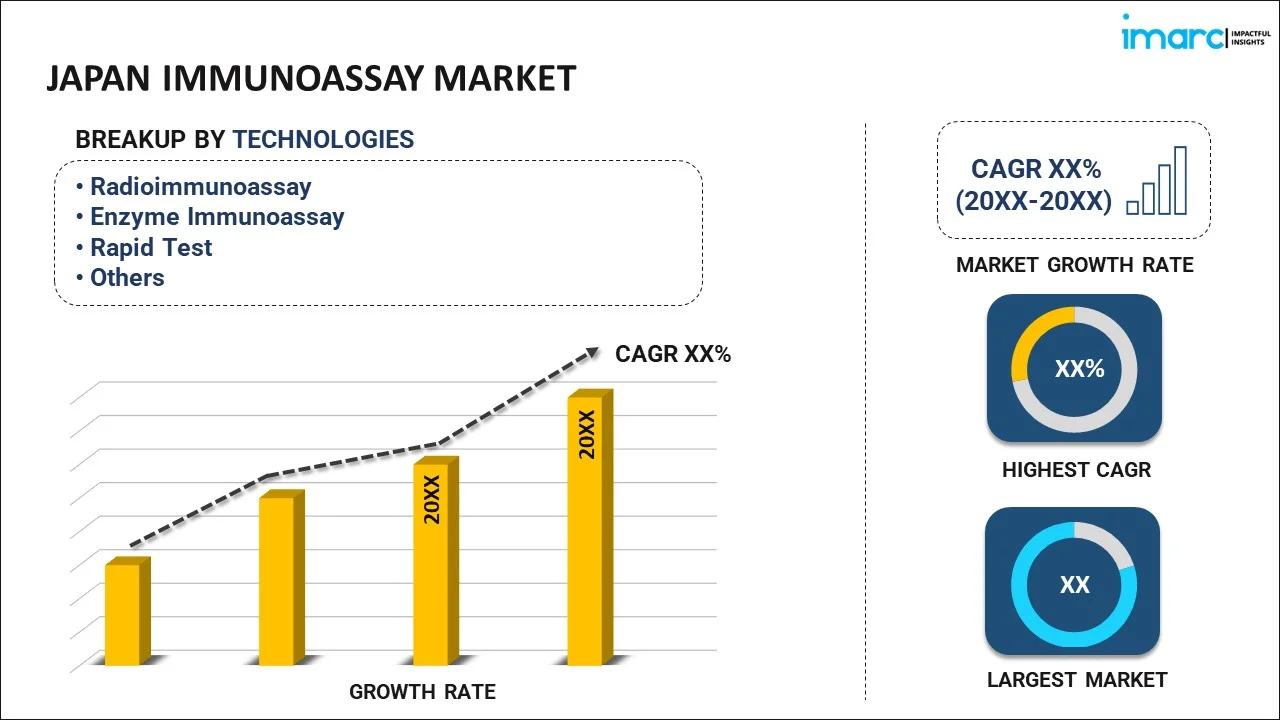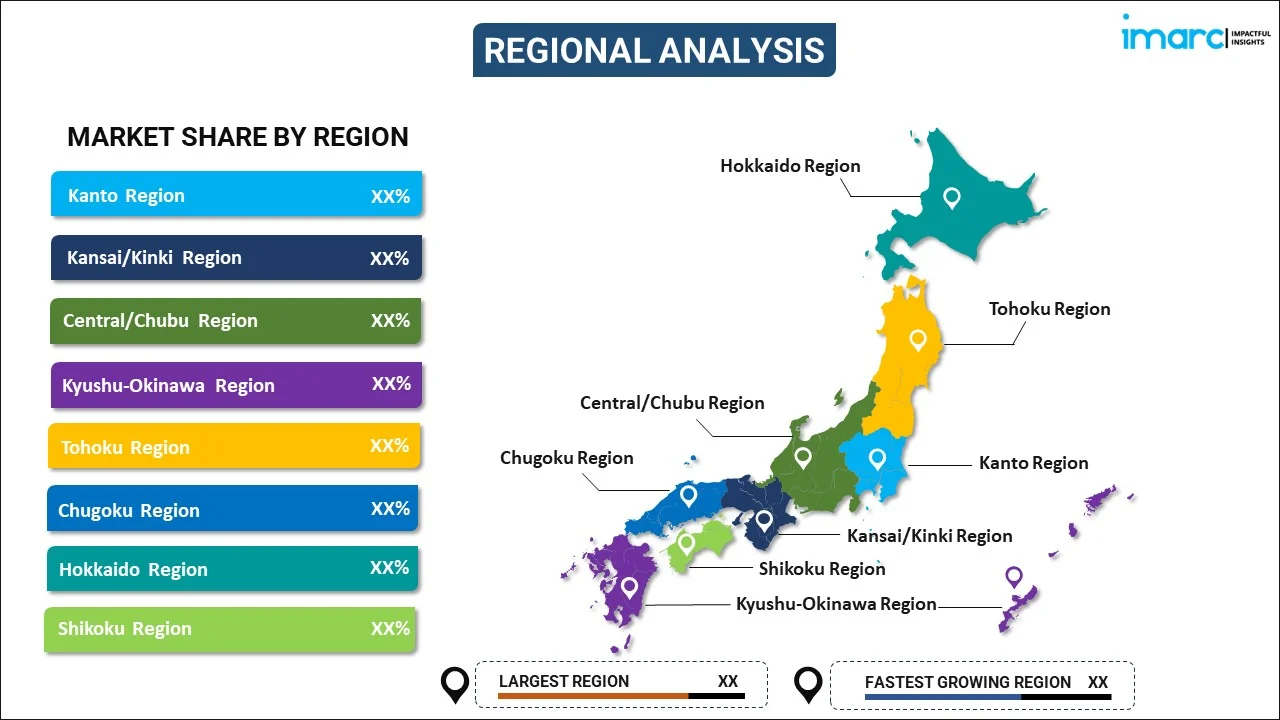
Japan Immunoassay Market Report by Technology (Radioimmunoassay, Enzyme Immunoassay, Rapid Test, and Others), Product (Reagents and Kits, Analyzers/Instruments, Software and Services), Application (Therapeutic Drug Monitoring, Oncology, Cardiology, Endocrinology, Infectious Disease Testing, Autoimmune Diseases, and Others), End Use (Hospitals, Blood Banks, Clinical Laboratories, Pharmaceutical and Biotech Companies, Academic Research Centers, and Others), and Region 2025-2033
Market Overview:
Japan immunoassay market size reached USD 1,958.9 Million in 2024. Looking forward, IMARC Group expects the market to reach USD 3,631.7 Million by 2033, exhibiting a growth rate (CAGR) of 6.75% during 2025-2033. The increasing prevalence of infectious diseases, chronic conditions, and cancer, coupled with the rising demand for diagnostic tests, including immunoassays, which are used for the detection of specific biomarkers associated with these ailments, is primarily driving the market.
|
Report Attribute
|
Key Statistics
|
|---|---|
|
Base Year
|
2024 |
|
Forecast Years
|
2025-2033 |
|
Historical Years
|
2019-2024
|
| Market Size in 2024 | USD 1,958.9 Million |
| Market Forecast in 2033 | USD 3,631.7 Million |
| Market Growth Rate (2025-2033) | 6.75% |
An immunoassay is a powerful laboratory technique used to detect and quantify specific molecules, such as proteins, hormones, or drugs, in biological samples like blood, urine, or tissue. It relies on the principles of the immune system to identify and measure these substances accurately. The process typically involves the use of antibodies, which are proteins that can bind specifically to target molecules called antigens. In an immunoassay, these antibodies are labeled with a detectable marker, such as a fluorescent dye or enzyme, making it possible to track their interactions with the target molecules. Immunoassays come in various forms, including enzyme-linked immunosorbent assays (ELISA), radioimmunoassays (RIA), and fluorescence immunoassays. They offer high sensitivity and specificity, making them valuable tools in medical diagnostics, pharmaceutical research, and various other fields. Immunoassays are widely used for detecting diseases, monitoring treatment responses, and conducting research studies, helping healthcare professionals and scientists better understand and manage a wide range of health conditions.
Japan Immunoassay Market Trends:
The immunoassay market in Japan is poised for significant growth in the coming years, primarily driven by several key factors. Firstly, the increasing prevalence of chronic diseases such as cancer, diabetes, and autoimmune disorders has propelled the demand for immunoassays. These assays play a crucial role in diagnosing and monitoring these conditions, fostering their adoption. Moreover, technological advancements in the field of immunoassays have been instrumental in expanding their applications. Innovations in assay formats, detection methods, and automation have improved the accuracy and sensitivity of immunoassays and also made them more user-friendly and cost-effective, driving their widespread adoption in clinical laboratories. Furthermore, the growing geriatric population in Japan is another significant driver for the immunoassay market. With age, the risk of chronic diseases rises, necessitating regular diagnostic testing, where immunoassays are indispensable. In conclusion, the convergence of factors, including disease prevalence, technological advancements, demographic trends, and the ongoing need for effective diagnostic tools in the face of evolving health challenges, is expected to drive the regional immunoassay market in the coming years.
Japan Immunoassay Market Segmentation:
IMARC Group provides an analysis of the key trends in each segment of the market, along with forecasts at the country level for 2025-2033. Our report has categorized the market based on technology, product, application, and end use.
Technology Insights:

- Radioimmunoassay
- Enzyme Immunoassay
- Rapid Test
- Others
The report has provided a detailed breakup and analysis of the market based on the technology. This includes radioimmunoassay, enzyme immunoassay, rapid test, and others.
Product Insights:
- Reagents and Kits
- Analyzers/Instruments
- Software and Services
A detailed breakup and analysis of the market based on the product have also been provided in the report. This includes reagents and kits, analyzers/instruments, and software and services.
Application Insights:
- Therapeutic Drug Monitoring
- Oncology
- Cardiology
- Endocrinology
- Infectious Disease Testing
- Autoimmune Diseases
- Others
The report has provided a detailed breakup and analysis of the market based on the application. This includes therapeutic drug monitoring, oncology, cardiology, endocrinology, infectious disease testing, autoimmune diseases, and others.
End Use Insights:
- Hospitals
- Blood Banks
- Clinical Laboratories
- Pharmaceutical and Biotech Companies
- Academic Research Centers
- Others
A detailed breakup and analysis of the market based on the end use have also been provided in the report. This includes hospitals, blood banks, clinical laboratories, pharmaceutical and biotech companies, academic research centers, and others.
Regional Insights:

- Kanto Region
- Kansai/Kinki Region
- Central/ Chubu Region
- Kyushu-Okinawa Region
- Tohoku Region
- Chugoku Region
- Hokkaido Region
- Shikoku Region
The report has also provided a comprehensive analysis of all the major regional markets, which include Kanto Region, Kansai/Kinki Region, Central/ Chubu Region, Kyushu-Okinawa Region, Tohoku Region, Chugoku Region, Hokkaido Region, and Shikoku Region.
Competitive Landscape:
The market research report has also provided a comprehensive analysis of the competitive landscape. Competitive analysis such as market structure, key player positioning, top winning strategies, competitive dashboard, and company evaluation quadrant has been covered in the report. Also, detailed profiles of all major companies have been provided.
Japan Immunoassay Market Report Coverage:
| Report Features | Details |
|---|---|
| Base Year of the Analysis | 2024 |
| Historical Period | 2019-2024 |
| Forecast Period | 2025-2033 |
| Units | Million USD |
| Scope of the Report | Exploration of Historical and Forecast Trends, Industry Catalysts and Challenges, Segment-Wise Historical and Predictive Market Assessment:
|
| Technologies Covered | Radioimmunoassay, Enzyme Immunoassay, Rapid Test, Others |
| Products Covered | Reagents and Kits, Analyzers/Instruments, Software and Services |
| Applications Covered | Therapeutic Drug Monitoring, Oncology, Cardiology, Endocrinology, Infectious Disease Testing, Autoimmune Diseases, Others |
| End Uses Covered | Hospitals, Blood Banks, Clinical Laboratories, Pharmaceutical and Biotech Companies, Academic Research Centers, Others |
| Regions Covered | Kanto Region, Kansai/Kinki Region, Central/ Chubu Region, Kyushu-Okinawa Region, Tohoku Region, Chugoku Region, Hokkaido Region, Shikoku Region |
| Customization Scope | 10% Free Customization |
| Post-Sale Analyst Support | 10-12 Weeks |
| Delivery Format | PDF and Excel through Email (We can also provide the editable version of the report in PPT/Word format on special request) |
Key Questions Answered in This Report:
- How has the Japan immunoassay market performed so far and how will it perform in the coming years?
- What has been the impact of COVID-19 on the Japan immunoassay market?
- What is the breakup of the Japan immunoassay market on the basis of technology?
- What is the breakup of the Japan immunoassay market on the basis of product?
- What is the breakup of the Japan immunoassay market on the basis of application?
- What is the breakup of the Japan immunoassay market on the basis of end use?
- What are the various stages in the value chain of the Japan immunoassay market?
- What are the key driving factors and challenges in the Japan immunoassay?
- What is the structure of the Japan immunoassay market and who are the key players?
- What is the degree of competition in the Japan immunoassay market?
Key Benefits for Stakeholders:
- IMARC’s industry report offers a comprehensive quantitative analysis of various market segments, historical and current market trends, market forecasts, and dynamics of the Japan immunoassay market from 2019-2033.
- The research report provides the latest information on the market drivers, challenges, and opportunities in the Japan immunoassay market.
- Porter's five forces analysis assist stakeholders in assessing the impact of new entrants, competitive rivalry, supplier power, buyer power, and the threat of substitution. It helps stakeholders to analyze the level of competition within the Japan immunoassay industry and its attractiveness.
- Competitive landscape allows stakeholders to understand their competitive environment and provides an insight into the current positions of key players in the market.
Need more help?
- Speak to our experienced analysts for insights on the current market scenarios.
- Include additional segments and countries to customize the report as per your requirement.
- Gain an unparalleled competitive advantage in your domain by understanding how to utilize the report and positively impacting your operations and revenue.
- For further assistance, please connect with our analysts.
 Inquire Before Buying
Inquire Before Buying
 Speak to an Analyst
Speak to an Analyst
 Request Brochure
Request Brochure
 Request Customization
Request Customization




.webp)




.webp)












